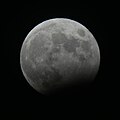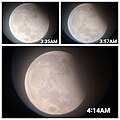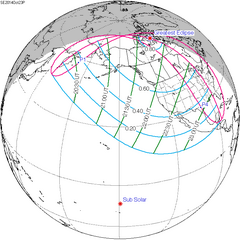|
October 2023 lunar eclipse
A partial lunar eclipse occurred at the Moon’s ascending node of orbit on Saturday, October 28, 2023,[1] with an umbral magnitude of 0.1234. A lunar eclipse occurs when the Moon moves into the Earth's shadow, causing the Moon to be darkened. A partial lunar eclipse occurs when one part of the Moon is in the Earth's umbra, while the other part is in the Earth's penumbra. Unlike a solar eclipse, which can only be viewed from a relatively small area of the world, a lunar eclipse may be viewed from anywhere on the night side of Earth. Occurring about 2.9 days after perigee (on October 25, 2023, at 23:00 UTC), the Moon's apparent diameter was larger.[2] VisibilityThe eclipse was completely visible over Africa, Europe, and Asia, seen rising over northeastern North America and eastern South America and setting over Australia and the western Pacific Ocean.[3]
Gallery
Eclipse detailsShown below is a table displaying details about this particular solar eclipse. It describes various parameters pertaining to this eclipse.[4]
Eclipse seasonThis eclipse is part of an eclipse season, a period, roughly every six months, when eclipses occur. Only two (or occasionally three) eclipse seasons occur each year, and each season lasts about 35 days and repeats just short of six months (173 days) later; thus two full eclipse seasons always occur each year. Either two or three eclipses happen each eclipse season. In the sequence below, each eclipse is separated by a fortnight.
Related eclipsesEclipses in 2023
Metonic
Tzolkinex
Half-Saros
Tritos
Lunar Saros 146
Inex
Triad
Lunar eclipses of 2020–2023This eclipse is a member of a semester series. An eclipse in a semester series of lunar eclipses repeats approximately every 177 days and 4 hours (a semester) at alternating nodes of the Moon's orbit.[5] The penumbral lunar eclipses on January 10, 2020 and July 5, 2020 occur in the previous lunar year eclipse set.
Metonic seriesThe metonic cycle repeats nearly exactly every 19 years and represents a Saros cycle plus one lunar year. Because it occurs on the same calendar date, the Earth's shadow will in nearly the same location relative to the background stars.
Saros 146This eclipse is a part of Saros series 146, repeating every 18 years, 11 days, and containing 72 events. The series started with a penumbral lunar eclipse on July 11, 1843. It contains partial eclipses from October 17, 2005 through May 14, 2348; total eclipses from May 25, 2366 through November 16, 2654; and a second set of partial eclipses from November 27, 2672 through June 12, 2997. The series ends at member 72 as a penumbral eclipse on August 29, 3123. The longest duration of totality will be produced by member 37 at 99 minutes, 22 seconds on August 8, 2492. All eclipses in this series occur at the Moon’s ascending node of orbit.[6]
Eclipses are tabulated in three columns; every third eclipse in the same column is one exeligmos apart, so they all cast shadows over approximately the same parts of the Earth.
Tritos seriesThis eclipse is a part of a tritos cycle, repeating at alternating nodes every 135 synodic months (≈ 3986.63 days, or 11 years minus 1 month). Their appearance and longitude are irregular due to a lack of synchronization with the anomalistic month (period of perigee), but groupings of 3 tritos cycles (≈ 33 years minus 3 months) come close (≈ 434.044 anomalistic months), so eclipses are similar in these groupings.
Half-Saros cycleA lunar eclipse will be preceded and followed by solar eclipses by 9 years and 5.5 days (a half saros).[8] This lunar eclipse is related to two partial solar eclipses of Solar Saros 153.
See alsoReferences
External links
|
|||||||||||||||||||||||||||||||||||||||||||||||||||||||||||||||||||||||||||||||||||||||||||||||||||||||||||||||||||||||||||||||||||||||||||||||||||||||||||||||||||||||||||||||||||||||||||||||||||||||||||||||||||||||||||||||||||||||||||||||||||||||||||||||||||||||||||||||||||||||||||||||||||||||||||||||||||||||||||||||||||||||||||||||||||||||||||||||||||||||||||||||||||||||||||||||||||||||||||||||||||||||||||||||||||||
Portal di Ensiklopedia Dunia
























































































